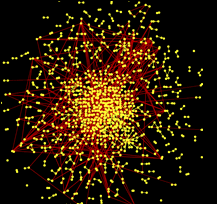
Research
Genetic and Metabolic Networks
Genetic and metabolic networks drive all biological processes. You can think of them as bridges between the organism and the individual molecules – proteins and genes – that form all living cells. We need to understand their structure, function, and evolution if we want to understand whole organisms. One research focus in the lab is the study of genome-scale transcriptional regulation networks, protein interaction networks, and metabolic networks. Another is the analysis of smaller regulatory circuits through detailed mathematical models of their molecular interactions. We are specifically interested in evolutionary questions, such as how natural selection shapes the structure of such networks, how evolutionary innovations arise in such networks, and what the evolutionary history of such networks looks like.
For instance, we have characterized the structure of the core metabolic network of the bacterium Escherichia coli, the evolution of the protein interaction network and the transcriptional regulation network of the yeast Saccharomyces cerevisiae. The metabolic network is an example of a small-world network, a type of network found in many unrelated areas of science, such as sociology and computer science. The structure of many small world networks contains information about their history. This means that we can use the structure of a metabolic network to infer which metabolites appeared early in the evolution of life. In our work on transcriptional regulation networks, we have focused on the evolution of small transcriptional regulation circuits. We have shown that such circuits have arisen by convergent evolution, a strong indicator that a network's structure is optimal for a given purpose.
Another important aspect of our work on networks regards the origin of new phenotypic traits. In a metabolic network, such new traits include the ability to thrive on new food sources; in transcriptional regulation circuits they comprise new expression patterns of regulatory genes; and in signaling circuits, they include new and beneficial signaling behaviors. By studying and comparing all three classes of systems, we can reveal powerful general principles that facilitate the origin of new traits. One of these principles is the existence of vast genotype networks, connected sets of circuit genotypes with the same phenotype. Such genotype networks allow a system to preserve an old existing phenotype while exploring many new phenotypes, until a superior phenotype is found.
To pursue these lines of inquiry, we analyze large genomic data sets and develop new computational and mathematical tools, such as tools to sample high dimensional parameter spaces efficiently.
Selected Publications
San Roman, M., Wagner, A. (2021) Diversity begets diversity during community assembly until ecological limits impose a diversity ceiling. Molecular Ecology 30, 5874-5887 [reprint request] ![]()
Hosseini, S.-R., Martin, O.C., Wagner, A. (2016) Phenotypic innovation through recombination in genome-scale metabolic networks. Proceedings of the Royal Society B: Biological Sciences 283: 20161536. [reprint request] ![]()
Hosseini, S.-R., Barve, A., Wagner, A. (2015) Exhaustive analysis of a genotype space comprising 1015 central carbon metabolisms reveals an organization conducive to metabolic innovation. PLoS Computational Biology 11 (8), e1004329. [reprint request] ![]()
Barve, A., Wagner, A. (2013) A latent capacity for evolutionary innovation through exaptation in metabolic systems. Nature 500, 203-206. [link]
Barve, A., Rodrigues, J.F.M., Wagner, A. (2012) Superessential reactions in metabolic networks. Proceedings of the National Academy of Sciences of the U.S.A. 109 (18), E1121-E1130. [reprint request] ![]()
Raman, K., Wagner, A. (2011) Evolvability and robustness in a complex signaling circuit. Molecular BioSystems 7, 1081-1092. [reprint request] ![]()
Rodrigues, J., Wagner, A. (2009) Evolutionary plasticity and innovations in complex metabolic reaction networks. PloS Computational Biology 5(12): e1000613. [reprint request] ![]()
Ciliberti, S., Martin, OC, Wagner, A. (2007) Innovation and robustness in complex regulatory gene networks. Proc. Natl. Acad. Sci. U.S.A. 104, 13591-13596. [reprint request] ![]()
Ciliberti, S, Martin, OC, Wagner, A. (2007) Robustness can evolve gradually in complex regulatory networks with varying topology. PLoS Computational Biology 3(2): e15. [reprint request] ![]()
Conant, G.C. Wagner, A. (2003) Convergent
evolution in gene circuits. Nature Genetics 34, 264-266 [PDF] ![]()